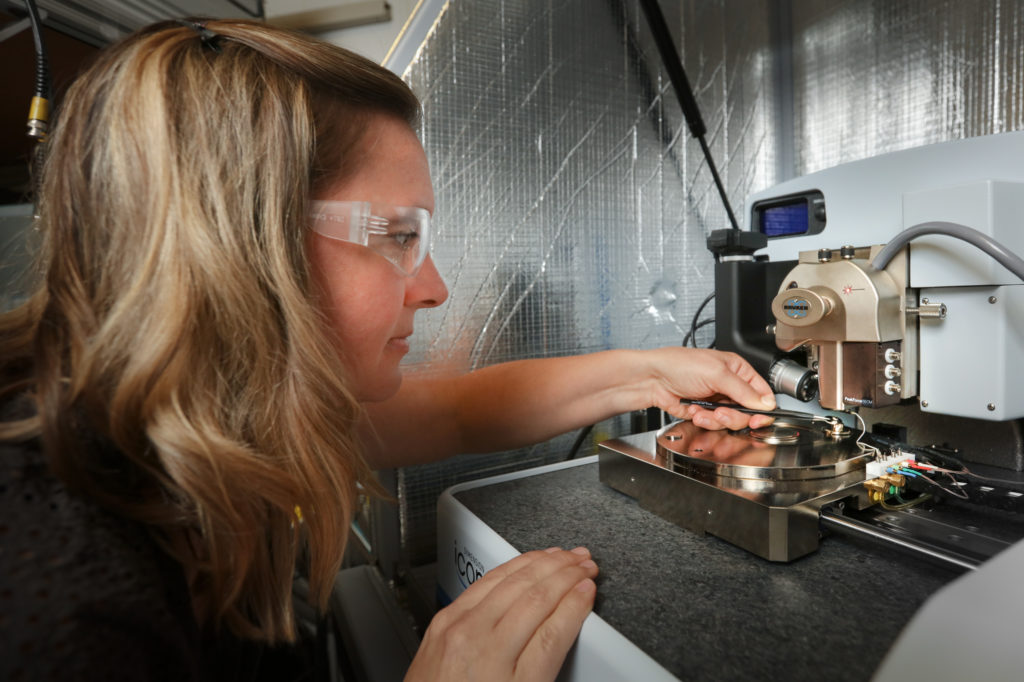When Nina Balke came to the United States on a Feodor Lynen Fellowship for German scholars, her original plan was to complete a year abroad and return home to native opportunities in materials sciences. Nearly 12 years later, she is still probing the nanoscale properties of materials at the Department of Energy’s Oak Ridge National Laboratory and seeking outdoor adventures in the Tennessee Valley.
As a researcher at ORNL’s Center for Nanophase Materials Sciences, a DOE Nanoscience User Facility, Balke explores avenues for fine-tuning materials’ physical properties to solve energy challenges and expands fundamental research opportunities for CNMS users.
“The approaches we are developing at the CNMS to characterize materials bring new experimental capabilities to the science community and enable discoveries that have not been possible before,” she said.
Beyond off-the-shelf
Supported by the Office of Science, Balke develops microscopy and imaging techniques to study materials at infinitesimal surface dimensions of 10–100 nanometers, the length scale just above atoms—which are tenths of nanometers in diameter—but well below the visible spectrum.
At the nanoscale, materials demonstrate unusual properties that are very different from those observed at the visible scale. Nanosized materials are often stronger, lighter, and more responsive to chemical and electrical reactions than their larger versions.
Harnessing these phenomena for nanotechnologies drives the nation’s energy advances, boosts performance in computers and electronics, improves medical treatments, and even introduces sunblock and wrinkle-free fabrics to consumers.
To observe materials on nanometer length scales, Balke uses a scanning probe microscope, a powerful instrument that scans the surfaces of materials with the tip of a 10-nanometer probe—so sharp it cannot be seen with the eye. Unlike optical microscopes, SPMs feelrather than see the way atoms interact, making it possible to measure volume changes in materials caused by various unseen forces of attraction and repulsion.
Balke specializes in developing techniques to examine the chemical, electrical, and mechanical processes—combined as “electrochemomechanical” systems—that take place as materials store and supply energy.
“When a voltage is applied to a material, for example, you can look at how the material responds on local scales, meaning you can map out how specific sample areas are involved and how their reactions vary across a sample,” she said.
While the tools of her trade may make new research areas possible, the vital work of discovery goes well beyond instruments’ off-the-shelf capabilities. When testing a hypothesis, off-the-shelf instruments can only take you so far, she says.
“The difficulty is that you will always measure something,” she said. “The hard part is taking the next step.”
Materials will respond to an electric field, for example, and instruments can help measure that response, but additional expertise is needed to interpret the results. “Are you observing ions moving through the material or heat or something else?—The biggest challenge is confirming that you are measuring what you think you are measuring,” said Balke.
A fundamental part of Balke’s microscopy work involves experimenting with many different materials to refine techniques for measuring properties and interpreting the results. The tremendous effort requires a big team, she says. Balke and other members of ORNL’s Scanning Probe Microscopy group design experiments, program software, and optimize instruments to advance nanoscience resources, which are shared with other researchers for free through the CNMS user program.
Pushing energy boundaries
Balke’s current research explores fundamental concepts in energy storage—at work in the materials that make up batteries, electrochemical capacitors, and other devices that generate as-needed electricity.
A DOE Early Career Award in 2011 jumpstarted her research on energy processes in battery materials. She is also involved in a collaborative effort with the Fluid Interface Reactions, Structures and Transport Center, established in 2009 as a DOE Energy Frontier Research Center at ORNL. FIRST uses CNMS resources to investigate the potential of energy storage materials, and Balke is leading the team’s research on “Coupled Electrolyte Ion and Electron Transport in Redox-Active Media.”
“One goal for energy storage is to marry the properties of fast-charging capacitors and long-lasting batteries to create materials that can charge quickly and store a lot of energy,” said Balke. “Characterizing materials’ nanoscale properties can point us toward pathways to tune, or tweak, materials to enhance their performance.”
Energy storage is only one pathway among endless opportunities, says Balke. Fundamental insights from her work on energy storage inform universal concepts for fine-tuning material properties for diverse energy applications.
Balke leads an Office of Science-funded program to explore materials’ functionality, broadly examining the way ions, or charged particles, move through materials and couple with other material properties.
As an example, her team applied microscopy approaches to a copper-based ferroelectric material (CuInP2S6) with promising chemical and electronic uses. Moving copper atoms from the material’s bulk to its surface enhanced electromechanical properties by 45%.
She credits ORNL’s collaborative environment with driving her research. “The passion and energy of the people you are working with is fuel for discovery,” she said. “When you are part of a team where everyone is working together to make an impact, it pushes the field forward.”
Balke’s work and life are balanced by her passion and energy for discovery. In both areas she believes in jumping into new experiences and fully appreciating the surroundings. Outside of work, she kayaks and mountain bikes, enjoying Tennessee’s outdoors with an American husband, two young kids, and a pair of dogs.
The CNMS is a DOE Office of Science User Facility available to the science community.
UT-Battelle manages ORNL for the DOE Office of Science. The single largest supporter of basic research in the physical sciences in the United States, the Office of Science is working to address some of the most pressing challenges of our time. For more information, please visit https://energy.gov/science.
scraped from https://www.newswise.com/articles/nina-balke-fine-tuned-science
